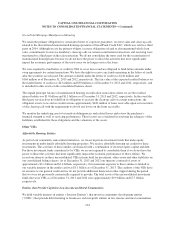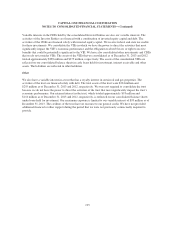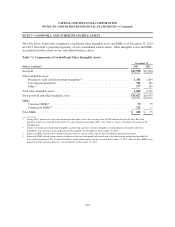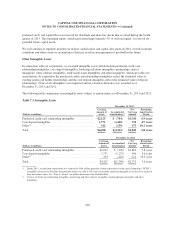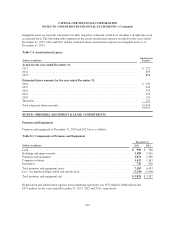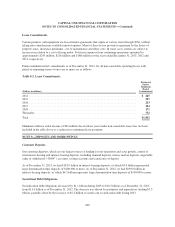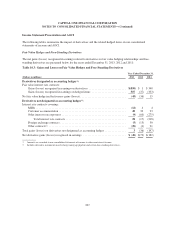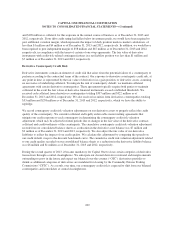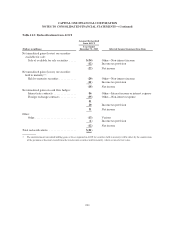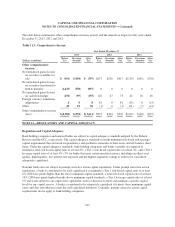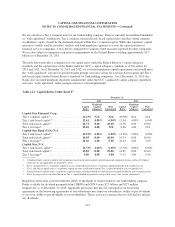Capital One 2013 Annual Report Download - page 224
Download and view the complete annual report
Please find page 224 of the 2013 Capital One annual report below. You can navigate through the pages in the report by either clicking on the pages listed below, or by using the keyword search tool below to find specific information within the annual report.
CAPITAL ONE FINANCIAL CORPORATION
NOTES TO CONSOLIDATED FINANCIAL STATEMENTS—(Continued)
NOTE 10—DERIVATIVE INSTRUMENTS AND HEDGING ACTIVITIES
Use of Derivatives
We manage our asset and liability position and market risk exposure in accordance with prescribed risk
management policies and limits established by our Market and Liquidity Risk Policy which is approved by our
Board of Directors. Our primary market risk stems from the impact on our earnings and economic value of equity
from changes in interest rates, to a lesser extent, changes in foreign exchange rate. We employ several techniques
to manage our interest rate sensitivity, which include changing the duration and re-pricing characteristics of
various assets and liabilities by using interest rate derivatives. Our current asset and liability management policy
also includes the use of derivatives to hedge foreign currency denominated transactions to limit our earnings
exposure to foreign exchange risk. We execute our derivative contracts in both the over-the-counter and
exchange-traded derivative markets. The majority of our derivatives are interest rate swaps. In addition we may
use a variety of other derivative instruments, including caps, floors, options, futures and forward contracts, to
manage our interest rate and foreign exchange risk. We also offer various derivatives to our customers as part of
our commercial banking business but usually offset our exposure through derivative transactions with other
counterparties.
Accounting for Derivatives
Our derivatives are designated as either qualifying accounting hedges or free-standing derivatives. Free-standing
derivatives consist of customer-accommodation derivatives and economic hedges that do not qualify for hedge
accounting. Qualifying accounting hedges are designated as fair value hedges or cash flow hedges.
•Fair Value Hedges: We designate derivatives as fair value hedges to manage our exposure to changes in the
fair value of certain financial assets and liabilities, which fluctuate in value as a result of movements in
interest rates. Changes in the fair value of derivatives designated as fair value hedges are recorded in
earnings together with offsetting changes in the fair value of the hedged item and any resulting
ineffectiveness. Our fair value hedges consist of interest rate swaps that are intended to modify our exposure
to interest rate risk on various fixed rate liabilities.
•Cash Flow Hedges: We designate derivatives as cash flow hedges to manage our exposure to variability in
cash flows related to forecasted transactions. Changes in the fair value of derivatives designated as cash
flow hedges are recorded as a component of AOCI, to the extent that the hedge relationships are effective,
and amounts are reclassified from AOCI to earnings as the forecasted transactions occur. To the extent that
any ineffectiveness exists in the hedge relationships, the amounts are recorded in current period earnings.
Our cash flow hedges consist of interest rate swaps that are intended to hedge the variability in interest
payments on some of our variable rate assets through 2019. These hedges have the effect of converting
some of our variable rate assets to a fixed rate. We also have entered into forward foreign currency
derivative contracts to hedge our exposure to variability in cash flows related to foreign currency
denominated intercompany borrowings.
•Free-Standing Derivatives: We use free-standing derivatives to hedge the risk of changes in the fair value
of residential MSR, mortgage loan origination and purchase commitments and other interests held. We also
categorize our customer-accommodation derivatives and the related offsetting contracts as free-standing
derivatives. Changes in the fair value of free-standing derivatives are recorded in earnings as a component
of other non-interest income.
204


